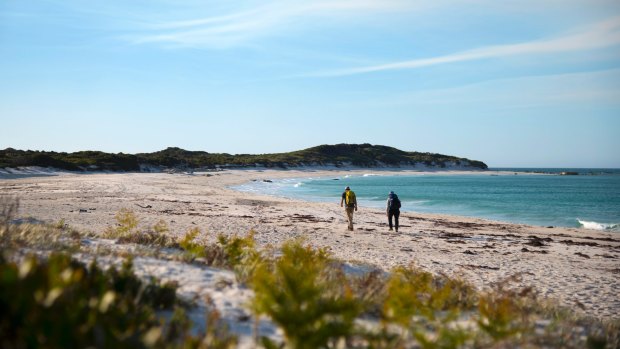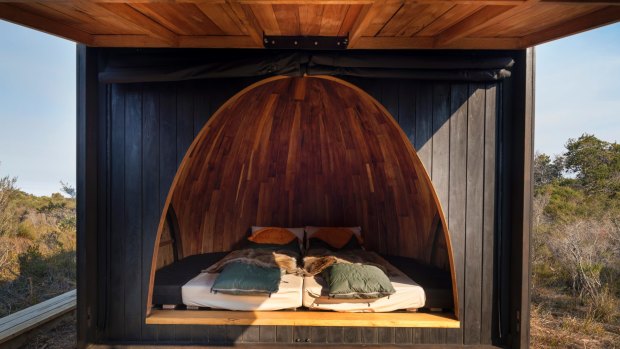This was published 3 years ago
Tasmania Indigenous tourism: Explore the history and culture of the palawa on this trek
By Kerry van der Jagt

The Bay of Fires is part of the wukalina walk.Credit: Rob Burnett
We need to let our people know we are coming," says Indigenous elder Clyde Mansell, as he welcomes us to his ancestors' country on Tasmania's north-east coast. Speaking in palawa kani, his voice starts strongly but falters midway.
Banished, banned and broken over the past 200 years, the ancient language is being revived. Pieced together from colonial diaries, songs passed down through families and audio recordings, palawa kani is a reconstruction of the dozen or so Indigenous languages that once existed across Tasmania.
Conscious of the significance, we gather at the base of wukalina (Mount William) in preparation for our 45-minute hike to the summit. It's the start of a seven-day escorted Tasmania's Footsteps and Trails tour, run by Inspiring Journeys.

The walk's unique sleeping experience.Credit: Rob Burnett
After a first night in Launceston our group of 10 (this was pre-pandemic) drives north-east for the start of the wukalina walk – the state's first and only multi-day trek through the Mount William National Park and Bay of Fires regions owned and operated by local Indigenous people. We'll trace the east coast from Launceston to Hobart – a little on foot, but mostly by vehicle – indulging in art, architecture and Indigenous culture while sampling some of the state's best food and wine.
Cut off from mainland Australia when sea levels rose about 10,000 years ago, the palawa (Indigenous peoples) of lutruwita (Tasmania) became among the most isolated on earth. From a population of about 15,000, only a few hundred palawa survived the brutalities inflicted by British colonists during the early 19th century.
"When Truganini passed away [in 1876], she was considered to be the last Tasmanian Aboriginal," says Carleeta Thomas, our palawa guide, as she leads us to the summit overlooking Bass Strait's offshore islands. "But 47 had also survived on Flinders Island after they had been detained there."
The shadows are long when we reach wukalina walk's standing camp of krakani lumi (resting place), our base for the next two nights.
Designed by Hobart architects Taylor + Hinds, the award-winning camp, based on the traditional shape of palawa seasonal shelters, consists of five sleeping pods and a domed communal hub looking onto a fire pit. After a communal dinner of scallops, mutton bird and roasted vegetables, I retire to my pod, falling asleep to the hum of the sea and the sweet scent of lemon myrtle.
The following morning, Carleeta and another guide, Djuker, take us to Cod Bay, pointing out dune-sized middens where the palawa once feasted, discarding shells and bones over thousands of years. Then it's an easy five-kilometre walk out of camp and a one-hour drive to larapuna – the Bay of Fires – with its white sand and orange lichen-plastered boulders.
The next day's high comes from the view over Wineglass Bay at Freycinet National Park. After a night at the elegant Edge of the Bay resort, we rise before dawn for the steep walk to the lookout over the famous crescent-shaped bay. Travelling south, there's an early lunch – including its signature wallaby, beetroot, hazelnuts and wattle-seed dish – at The Source Restaurant in Hobart's Museum of New and Old Art.
Our final two nights are spent in Hobart, combined with a day trip to Bruny Island, where Truganini was born and which William Bligh (of Bounty fame) first visited in 1777. As we cruise past some of Australia's tallest sea cliffs, hulking stacks of dolerite seem to prop up the bountiful island.
Kerry van der Jagt was a guest of Inspiring Journeys; inspiringjourneys.com.
This article appears in Sunday Life magazine within the Sun-Herald and the Sunday Age on sale September 13.
Sign up for the Traveller Deals newsletter
Get exclusive travel deals delivered straight to your inbox. Sign up now.